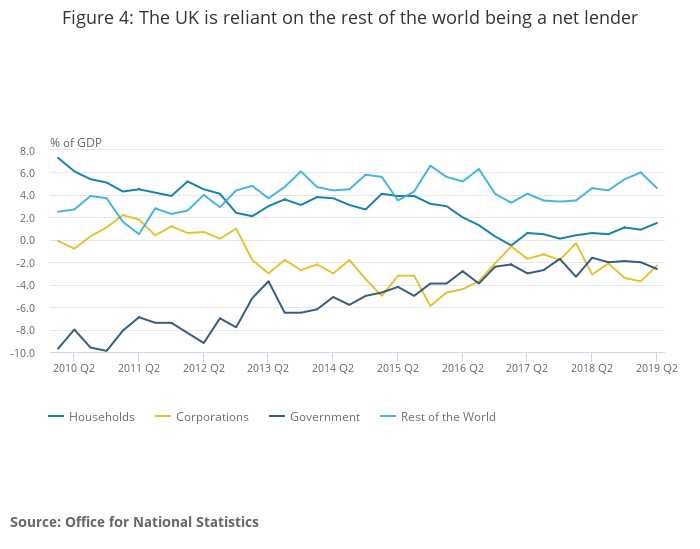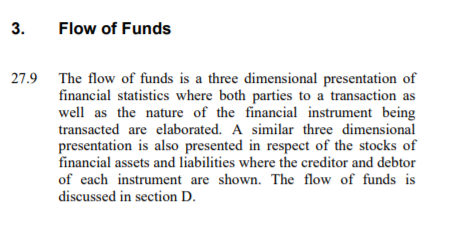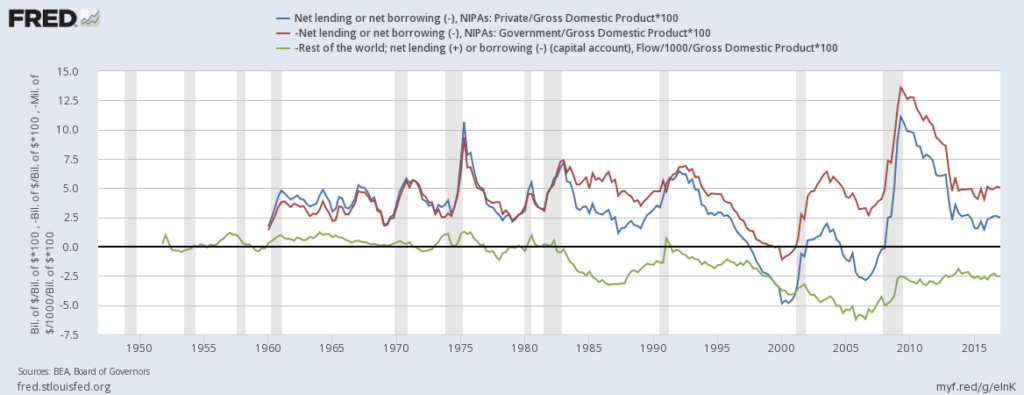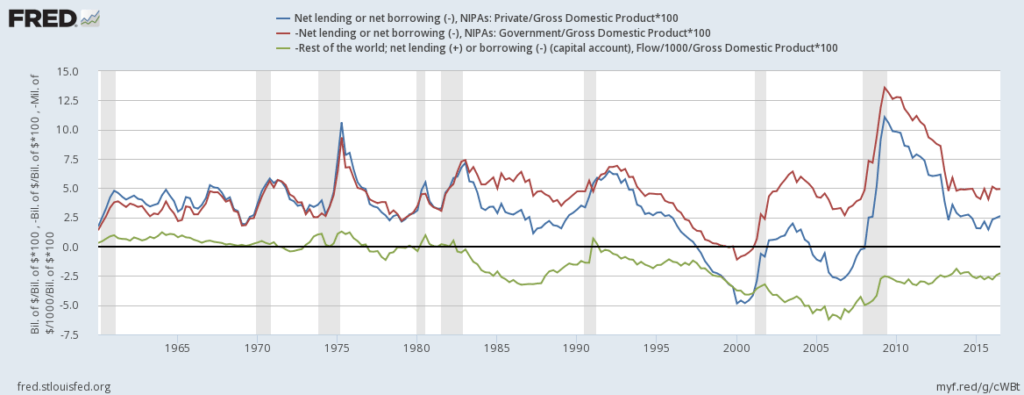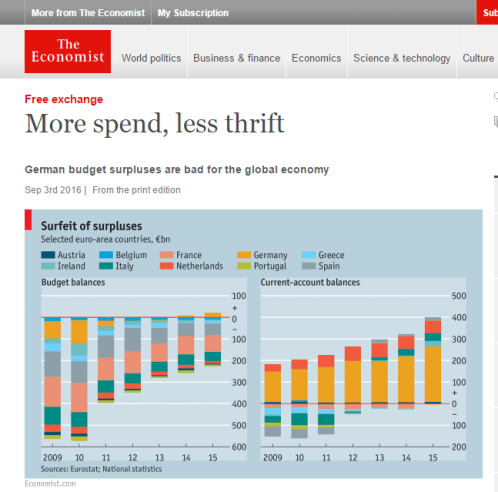The new issue of ROKE is out and celebrates 80 years of The General Theory. Nick Rowe has a new paper in the issue titled, Keynesian Parables Of Thrift And Hoarding. Requires access. Nick has a post on his blog where he welcomes comments.
Abstract:
I argue that Keynes missed seeing the importance of the distinction between saving in the form of money (‘hoarding’) and saving in all other forms (‘thrift’). It is excessive hoarding, not excessive thrift, that causes recessions and the failure of Say’s law. The same failure to distinguish hoarding from thrift continues from The General Theory into the IS–LM model and into New Keynesian macroeconomics. On this particular question, economists should follow Silvio Gesell rather than John Maynard Keynes. The rate of interest in New Keynesian models should be interpreted as a negative Gesellian tax (that is, a subsidy) on holding money issued by the central bank.
In my opinion, a part of it, the distinction between what’s called “hoarding” and “thrift” above is not something which Keynesians haven’t considered. In fact, in the sectoral balances approach, it is net lending and not saving whose behaviour is more highlighted.
A sector’s or an economic unit’s saving is defined as its disposable income less consumption expenditure.
S = YD − C
On the other hand, a sector’s net lending is defined as its disposable income less expenditure.
NL = YD − C − I
These things are not as straightforward as they look. Here’s an example. I can be both a saver and borrower.
Let’s say, I start with no assets/liabilities, earn $1mn in a year, pay taxes of $200,000, have consumption expenditure of $100,000 and buy a house worth $5m by borrowing $4.3m from a bank.
My saving is $700,000 and my net lending is minus $4.3 million [ = ($1mn − $200,000) − $300,000 − $5m].
Of course, the fact that I am a net borrower doesn’t make me poor. My house is worth $5m and I have a liability of $4.3m which implies my net worth is $700,000.
However, my liquidity is low. If tomorrow the economy collapses and I lose my job, I will be in a bad situation. In short, negative net lending (or a negative financial balance) of an economic unit or a sector contributes to financial fragility.
There’s another important point: even though I am a saver, my saving rate is 7/8, I have contributed hugely to aggregate demand. This can happen at a sectoral level as well. So perhaps this is the reason why Nick Rowe makes this distinction.
So if we were to blindly believe in Keynes, we would have concluded wrongly by just looking at the saving rate. But it is a matter of emphasis: economists make ceteris paribus arguments and I do not think Keynes didn’t understand this. He was perhaps holding everything else constant and changing the propensity to consume to highlight an important fact. But in real life ceteris is never paribus. What Keynes was arguing was that saving is not necessarily a good thing at the macro level.
Back to sectoral balances. Since, a sector’s (such as the household sector’s) negative net lending (or negative financial balance) adds to its financial fragility, this process will reverse. Private expenditure relative to private disposable income will fall. But this has an effect of being a drain on aggregate demand. And this can cause a recession.
Nick Rowe would have argued that it is the demand for money which caused a recession. Till here, it’s the same as argued above, because private expenditure falling relative to income is due to economic units trying to increase their liquidity. (There’s a “paradox” here: all units trying to reduce their fragility causes more fragility!).
There is however a difference: a sector’s or economic units’ demand for “money” can also be independent to income/expenditure and is more related to asset allocation between various kinds of financial assets. But here it cannot be said to cause a fall in aggregate demand and output. So a higher demand for money per se cannot be said to cause a recession.
As I was finishing writing this, JKH put up a comment at Nick’s blog saying Keynes understood it. I reproduce the comment below.
JKH:
There’s no question that Keynes appreciated the distinction between thrift and hoarding:
GT Chapter 9
“The rise in the rate of interest might induce us to save more, if our incomes were unchanged. But if the higher rate of interest retards investment, our incomes will not, and cannot, be unchanged. They must necessarily fall, until the declining capacity to save has sufficiently offset the stimulus to save given by the higher rate of interest. The more virtuous we are, the more determinedly thrifty, the more obstinately orthodox in our national and personal finance, the more our incomes will have to fall when interest rises relatively to the marginal efficiency of capital. Obstinacy can bring only a penalty and no reward. For the result is inevitable.”
GT Chapter 13
“The concept of hoarding may be regarded as a first approximation to the concept of liquidity-preference. Indeed if we were to substitute ‘propensity to hoard’ for ‘hoarding’, it would come to substantially the same thing. But if we mean by ‘hoarding’ an actual increase in cash-holding, it is an incomplete idea — and seriously misleading if it causes us to think of ‘hoarding’ and ‘not-hoarding’ as simple alternatives. For the decision to hoard is not taken absolutely or without regard to the advantages offered for parting with liquidity; — it results from a balancing of advantages, and we have, therefore, to know what lies in the other scale. Moreover it is impossible for the actual amount of hoarding to change as a result of decisions on the part of the public, so long as we mean by ‘hoarding’ the actual holding of cash. For the amount of hoarding must be equal to the quantity of money (or — on some definitions — to the quantity of money minus what is required to satisfy the transactions-motive); and the quantity of money is not determined by the public. All that the propensity of the public towards hoarding can achieve is to determine the rate of interest at which the aggregate desire to hoard becomes equal to the available cash. The habit of overlooking the relation of the rate of interest to hoarding may be a part of the explanation why interest has been usually regarded as the reward of not-spending, whereas in fact it is the reward of not-hoarding.”
Being the supreme macro-accountant (the first one really), he would be totally in tune with the general stock/flow consistency theme of the post-Keynesians.
Hoarding is a stock/asset allocation of liquidity, interconnected with the determination of the interest rate, as he notes above. He correctly rejected the idea of the interest rate as being determined by an “equilibrium” of saving and investment. He maintained correctly that those two measures are continuously equivalent.
Recession dynamics are a flow phenomenon as he describes it, using reconciliation of income accounting at two different points in time.
The behavior of liquidity, hoarding, and the interest rate is stock behavior (including hoarding) within that saving flow dynamic (including thrift).
